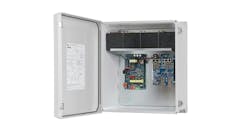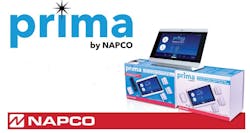A residential break-in occurs in the United States every 14 seconds. The majority of these intruders enter through open and unprotected windows. Of course many of these residences do not have an alarm system and some have alarm systems which weren't activated at the time of the intrusion.
Why? Many homeowners wish to keep their windows open, and with the typical alarm system design, you have to disarm the system to open a protected window.
In alarm vernacular, “protected” usually means magnetic contacts are installed so that if the window is open, the alarm system knows. And if the window is opened while the system is armed, it will cause an alarm.
Higher-end systems will offer glass break detection, that is an electronic sensor which is designed to listen for the frequencies produced when glass is broken.
Some readers will recall that at one time, glass protection was done with window foil. Window foil is narrow metal tape (lead?) glued to the window in a pattern near the edges. The foil is delicate and is attached with polyurethane, which adds to the rigidity of the foil and makes it even more likely to rupture if the glass breaks. Foil can be damaged by objects brushing against it, or the combined effects of condensation and temperature changes.
Foil installation is more or less a lost art. Try to buy foil sometime; it's difficult to even find a vendor for it. Foil installation is also labor intensive, meaning it requires a relatively high degree of skill and it takes a bit of time to do.
During the evolution of the security industry, the use of foil was popular at about the same time as the use of a house loop. A house loop meant that all the openings in a premises (except maybe entry doors) would be wired in series with each other. So you could have several windows, all of which looked like two wires at the alarm panel. The result was if one of the circuits was opened anywhere in the premises, the whole loop was open and the alarm could not be used.
Even though the problem with this technique was just as much the fact that all the openings were on one loop, as it was the inherent shortcomings of window foil, the foil took most of the blame.
Early alarm panels were essentially a relay whose coil was wired in series with the house loop and a battery. A single zone alarm system was quite common.
More sophisticated alarm technologies such as interior motion detection, multiple zone alarm systems, and later, effective glass break detection fostered advances in system designs essentially overnight.
So even though systems were becoming “zoned,” that is each opening was individually wired or wirelessly connected to the panel, and therefore problems could be more easily isolated and repaired; window foil's era had ended.
Foil had a bad reputation for being high maintenance; its first name was synonymous with blood poisoning, and in addition, it took a skilled individual a long time to install it.
Window foil is still available, but it is now “lead-free” and is made from aluminum, therefore it cannot be soldered like the original foil.
The typical alarm system today offers each opening on its own zone; each window and door has a contact which senses if it is open or closed, and interior motion detectors. When the client is away from home, all sensors are activated. The theory is if a window or door is opened, the alarm will go off. If the burglar manages to circumvent the door or window contact, he will eventually be picked up by an interior motion detector. If the client can afford it, glass break sensors are added to listen for forced entry.
Many clients do not like feeling trapped in their own homes by their security systems. They do not want to keep their windows closed, because they want fresh air and gentle breezes. But they still wish to have the protection of their electronic security system, while being able to move around freely inside.
A solution I've used for several years are devices referred to as security screens. At one point in time, I fabricated my own screens. These screens were the residential equivalent to another security device which has essentially disappeared, the wood alarm grills. The wood alarm grills were constructed of grooved dowels into which fine solid wire was placed. The wires formed a circuit and if the grill was broken during a break-in, the alarm would go off. The screens used a non-metallic mesh which had fine wires woven into it which also formed a circuit.
I would obtain the various components required and either manufacture screens or modify a client's existing screens for a system.
The materials required were the screening itself, which came in several sizes to accommodate anything from a small window to a patio door, the wire, the tamper switches, the grommets, special rubber ribbing, assorted adhesives, and so forth.
If it was necessary to fabricate a screen, then I'd have to buy the aluminum extrusions and plastic corners from which screens are assembled. Back then, most serious alarm dealers made their own screens. The market for security screens had to do with your area of the country, if you were doing high –end systems, and your ability to sell.
We recently did an alarm project, and the client expressed a strong desire to enjoy the fresh air and birds singing. So I broke out my old screen sample and made a presentation.
The client was enthralled by the concept. Then I had to figure out what I would do to fulfill the order. Build or buy?
I hit the Internet and was grateful to locate a professional alarm screen fabricator who was alive and well and staying rather busy building screens for the residences of security conscious federal government employees in the metro Washington DC area. (See http://www.securityscreens.com .)
I did a phone interview and was impressed with the answers. They offered the range of options that I as a system designer, dealing with a moderate-to-severely picky client, needed.
We decided which screens we'd modify. After all, certain windows were inaccessible to attack, and in some rooms, the client didn't feel a need to open the windows.
I had the contractor remove the existing screens and bring them in to our shop. Unfortunately, even though they were brand new, the screens were low quality and poorly constructed, and I didn't want to invest money in having them modified.
You need screen frames with at least the physical integrity of typical replacement window screens, (which are, by the way, pretty decent).
The screen contractor again had a nice choice of extrusions, colors and options, and I was able to easily convince my client that it was a worthwhile investment, so we went ahead and measured everything carefully and ordered all new screens.
The alarm screens mount using a top track and a hook and bale at the bottom to hold them shut.
In our case we ordered the screens supplied with wires and plugs which connect to the wireless alarm transmitters. The screens could just as easily be connected to a hard-wired alarm system.
The screens also have concealed tamper switches. These are so if the screen is removed from the frame, it also cause an alarm. The screening material is laced with a fine wire. If the fine wire is cut or if the screen is dislodged from its frame, the alarm goes off.
These screens can remain “on” all the time. Additionally they can be easily removed for window cleaning. In an emergency, the screen does not pose an impediment to egress, as do metal grills and window guards I've used in the past.
I do not recall ever getting an objection to the appearance of these screens from a client. You need to study them closely to even notice they're modified, and there are no restrictions on windows treatments or decorating.
Many alarm system clients will not be interested at all in alarm screens. They probably expect you to give them the alarm system anyway. They hear that's how it ought to be by watching TV. This is not for them, and that kind of client probably isn't for you either.
Tim O'Leary
Tim O'Leary is a security consultant, trainer and technician who has also been writing articles on all areas of locksmithing & physical security for many years.





